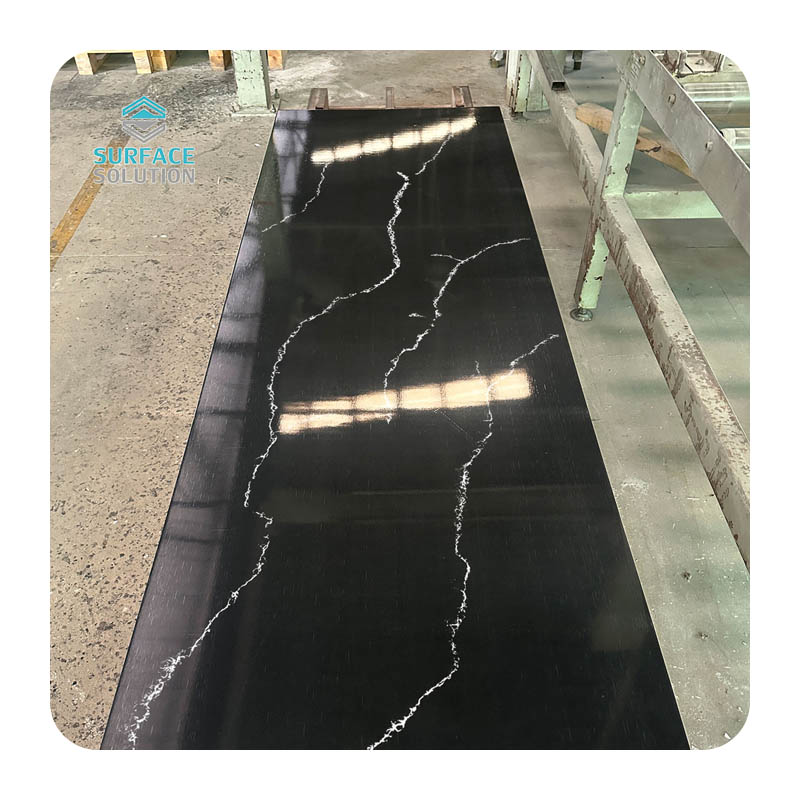
Artificial Stone Bathroom Cabinet Selection Pure Acrylic Vs. Composite Acrylic

When it comes to choosing an artificial stone bathroom cabinet, one of the key decisions is between pure acrylic and composite acrylic. Both materials have their own unique characteristics, advantages, and considerations, which can significantly impact your long - term satisfaction with the bathroom cabinet.
1. Material Composition
Pure Acrylic
Pure acrylic solid surface is mainly composed of acrylic resin. This high - purity resin base gives it a uniform and smooth texture at the molecular level. Acrylic resin is known for its excellent transparency and light - transmitting properties, which contribute to the vivid and natural - looking colors that pure acrylic bathroom cabinets can achieve. For example, a pure acrylic countertop can have a depth of color and a translucency that mimics natural stones like marble in a very realistic way.

Composite Acrylic
Composite acrylic, on the other hand, is a blend of acrylic resin and other fillers such as aluminum hydroxide. The addition of these fillers changes the material's physical properties. Aluminum hydroxide, for instance, improves the fire - resistance and hardness of the composite material. This combination aims to balance the advantages of acrylic resin with the enhanced performance provided by the fillers.
2. Physical Properties
Durability
- Pure Acrylic: Pure acrylic is relatively soft compared to some other materials. While it is resistant to staining and fading due to its non - porous nature, it can be more prone to scratches. However, minor scratches can often be buffed out, restoring the surface to its original appearance.
- Composite Acrylic: Thanks to the addition of fillers, composite acrylic is generally more scratch - resistant than pure acrylic. The aluminum hydroxide and other components increase its hardness, making it better able to withstand the daily wear and tear in a bathroom environment, such as being scratched by toiletries or cleaning tools.
Heat Resistance
- Pure Acrylic: It has a moderate heat resistance. Direct contact with very hot objects, such as a boiling kettle, can cause damage to the surface, like leaving a white mark or deforming the material slightly.
- Composite Acrylic: With the inclusion of heat - resistant fillers, composite acrylic has better heat resistance. It can tolerate higher temperatures for a short period without significant damage, making it more suitable for bathrooms where hot styling tools might be placed on the countertop.
3. Aesthetic Appeal
Pure Acrylic
Pure acrylic offers a wide range of color options with high saturation and a glossy finish that gives a luxurious and modern look. The smooth surface also makes it easy to clean, maintaining its pristine appearance. It can create a seamless and elegant aesthetic in the bathroom, especially in contemporary - designed spaces.
Composite Acrylic
Composite acrylic can also achieve a variety of colors and finishes, but it may not have the same level of translucency and high - gloss shine as pure acrylic. However, its surface texture can sometimes mimic natural stones more closely in terms of grain and pattern, which is appealing for those who prefer a more traditional or natural - looking bathroom decor.
4. Cost
Pure Acrylic
Due to its high - quality acrylic resin composition and the relatively complex manufacturing process to ensure purity, pure acrylic bathroom cabinets are generally more expensive. This cost reflects the material's premium features, such as its excellent color fastness and aesthetic qualities.
Composite Acrylic
Composite acrylic is often a more budget - friendly option. The use of fillers reduces the amount of expensive acrylic resin required, making it an attractive choice for those who want the benefits of acrylic - based materials without the high price tag. It offers a good balance between cost and performance for many consumers.
5. Maintenance
Pure Acrylic
As mentioned, pure acrylic is non - porous, which means it resists the absorption of water, soap scum, and stains. Regular cleaning with a mild detergent and a soft cloth is usually sufficient to keep it looking new. In case of scratches, as previously stated, they can be easily removed with proper buffing.
Composite Acrylic
Composite acrylic also has good stain - resistance, but its slightly rougher surface texture (compared to pure acrylic) may require a bit more effort in cleaning to ensure that no dirt or soap residue gets trapped in the small crevices. However, overall, it is still relatively low - maintenance.
In conclusion, when choosing between a pure acrylic and a composite acrylic artificial stone bathroom cabinet, consider your priorities. If you value a high - end aesthetic, vivid colors, and are willing to pay more for a product with a luxurious feel, pure acrylic might be the right choice. On the other hand, if you need a more durable, cost - effective, and heat - resistant option with a relatively natural - looking appearance, composite acrylic could be the better fit for your bathroom renovation project.
Related Blogs
-
 What Is Solid Surface Material? A Complete GuideIn the world of interior design and home renovation, "solid surface material" is a term frequently heard—but what exactly is it? Unlike natural materials mined from the earth or rigid synthetic alternatives, solid surface is a engineered man-made mater
What Is Solid Surface Material? A Complete GuideIn the world of interior design and home renovation, "solid surface material" is a term frequently heard—but what exactly is it? Unlike natural materials mined from the earth or rigid synthetic alternatives, solid surface is a engineered man-made mater -
 What Are Solid Surface Countertops Made Of? A Comprehensive BreakdownSolid surface countertops have become a popular choice in modern kitchens and bathrooms, celebrated for their seamless appearance, durability, and versatility. Unlike natural stone (such as granite or marble) or ceramic tiles, soli
What Are Solid Surface Countertops Made Of? A Comprehensive BreakdownSolid surface countertops have become a popular choice in modern kitchens and bathrooms, celebrated for their seamless appearance, durability, and versatility. Unlike natural stone (such as granite or marble) or ceramic tiles, soli













